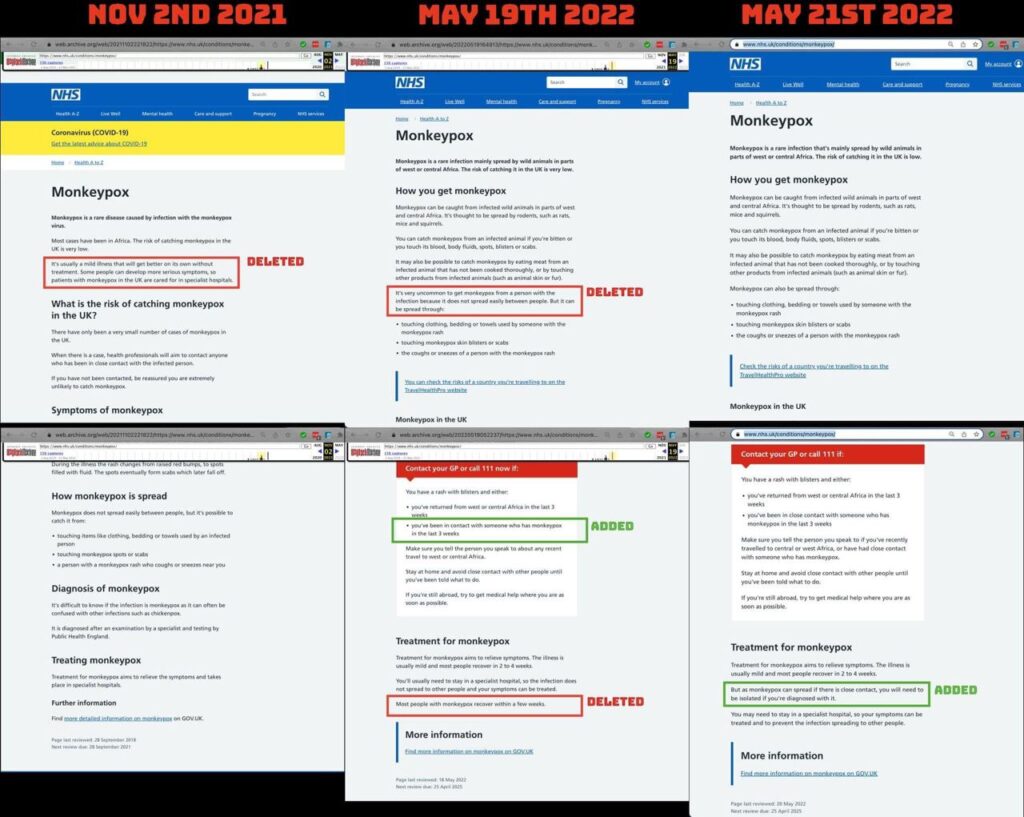www2.hse.ie /conditions/monkeypox/
HSE
www2.hse.ie /conditions/monkeypox/
Monkeypox is a rare infection. It’s mainly spread by wild animals in parts of west or central Africa.
The risk of catching it in Ireland is very low.
How you get monkeypox
You can get monkeypox from infected wild animals in parts of west and central Africa. It’s thought to be spread by rodents, such as rats, mice and squirrels.
You can catch monkeypox from an infected animal if you’re bitten by it or you touch its blood, body fluids, spots, blisters or scabs.
It may also be possible to catch monkeypox by:
- eating meat from an infected animal that has not been cooked thoroughly
- touching other products from infected animals, such as animal skin or fur
It’s very uncommon to get monkeypox from someone else. It does not spread easily between people. It takes close physical contact to spread between people.
The biggest risk of spread between people is through sexual contact or close contact with family members.
It can also be spread through:
- touching clothing, bedding or towels used by someone with the monkeypox rash
- touching monkeypox skin blisters or scabs
- the coughs or sneezes of a person with the monkeypox rash
Gay, bisexual and men who have sex with men may be at increased risk of catching monkeypox. This follows a number of recent cases in men in this community in the UK.
Monkeypox in Ireland
There are currently no reported cases in Ireland.
If you’ve been in close contact with someone who has monkeypox, you’ll be contacted by health professionals.
If you have not been contacted, and you have not travelled to west or central Africa, it’s extremely unlikely you have monkeypox.
Symptoms of monkeypox
It usually takes between 5 and 21 days for the first symptoms to appear.
The first symptoms of monkeypox include:
- a high temperature (38 degrees Celsius or higher)
- a headache
- muscle aches
- backache
- swollen glands
- shivering (chills)
- exhaustion
A rash usually appears 1 to 5 days after the first symptoms. The rash often begins on the face, then spreads to other parts of the body. If monkeypox has been spread through sexual contact, the rash can appear around the genitals.
The rash is sometimes confused with chickenpox. It starts as raised spots, which turn into small blisters filled with fluid. These blisters eventually form scabs which later fall off.
The symptoms usually clear up in 2 to 4 weeks.
Very occasionally people with a very weak immune system or very young babies can get a severe illness.
Urgent advice: Contact a GP if you have:
- symptoms of monkeypox and have recently returned from west or central Africa
- been in contact with someone who has monkeypox
Gay, bisexual and men who have sex with men should also look out for any unusual rashes or spots on their body, especially their genitals. Contact a GP or local STI Clinic for advice.
Things you can do to avoid getting monkeypox
Monkeypox is rare. But there are things you can do to reduce your risk of getting it while travelling in west and central Africa.
Do
- wash your hands with soap and water regularly or use an alcohol-based hand sanitiser
- only eat meat that has been cooked thoroughly
Don’t
- do not go near wild or stray animals, including dead animals
- do not go near any animals that appear unwell
- do not eat or touch meat from wild animals (bush meat)
- do not share bedding or towels with people who are unwell and may have monkeypox
- do not have close contact with people who are unwell and may have monkeypox
Treatment for monkeypox
Treatment for monkeypox aims to relieve symptoms. The illness is usually mild. Most people recover in 2 to 4 weeks.
You’ll usually need to stay in hospital. This is so the infection does not spread to other people and your symptoms can be treated.
Content supplied by the NHS and adapted for Ireland by the HSE
NHS
https://www.nhs.uk/conditions/monkeypox/
Page last reviewed: 23 May 2022
Next review due: 25 April 2025
Monkeypox
Monkeypox is a rare infection that’s mainly spread by wild animals in parts of west or central Africa. The risk of catching it in the UK is low.
How you get monkeypox
Monkeypox can be caught from infected wild animals in parts of west and central Africa. It’s thought to be spread by rodents, such as rats, mice and squirrels.
You can catch monkeypox from an infected animal if you’re bitten or you touch its blood, body fluids, spots, blisters or scabs.
It may also be possible to catch monkeypox by eating meat from an infected animal that has not been cooked thoroughly, or by touching other products from infected animals (such as animal skin or fur).
Monkeypox can also be spread through:
- touching clothing, bedding or towels used by someone with the monkeypox rash
- touching monkeypox skin blisters or scabs
- the coughs or sneezes of a person with the monkeypox rash
Information:
Check the risks of a country you’re travelling to on the TravelHealthPro website
Monkeypox in the UK
Only a small number of people have been diagnosed with monkeypox in the UK.
You’re extremely unlikely to have monkeypox if:
- you have not recently travelled to west or central Africa
- you have not been in close contact with someone who has monkeypox (such as touching their skin or sharing bedding)
Things you can do to avoid getting monkeypox
Although monkeypox is rare, there are things you can do to reduce your risk of getting it.
Do
wash your hands with soap and water regularly or use an alcohol-based hand sanitiser
- only eat meat that has been cooked thoroughly
Don’t
do not go near wild or stray animals, including dead animals
do not go near any animals that appear unwell
do not eat or touch meat from wild animals (bush meat)
do not share bedding or towels with people who are unwell and may have monkeypox
- do not have close contact with people who are unwell and may have monkeypox
Symptoms of monkeypox
If you get infected with monkeypox, it usually takes between 5 and 21 days for the first symptoms to appear.
The first symptoms of monkeypox include:
- a high temperature
- a headache
- muscle aches
- backache
- swollen glands
- shivering (chills)
- exhaustion
A rash usually appears 1 to 5 days after the first symptoms. The rash often begins on the face, then spreads to other parts of the body.
The rash is sometimes confused with chickenpox. It starts as raised spots, which turn into small blisters filled with fluid. These blisters eventually form scabs which later fall off.
The symptoms usually clear up in 2 to 4 weeks.
Urgent advice: Contact your GP or call 111 if:
You have a rash with blisters and either:
- you’ve been in close contact with someone who has symptoms of monkeypox
- you’ve been to west or central Africa in the past 6 weeks
Make sure you tell the person you speak to if you’ve had close contact with someone who has monkeypox symptoms, or if you’ve recently travelled to central or west Africa.
Stay at home and avoid close contact with other people until you’ve been told what to do.
If you’re still abroad, try to get medical help where you are as soon as possible.
Treatment for monkeypox
Treatment for monkeypox aims to relieve symptoms. The illness is usually mild and most people recover in 2 to 4 weeks.
But as monkeypox can spread if there is close contact, you will need to be isolated if you’re diagnosed with it.
You may need to stay in a specialist hospital, so your symptoms can be treated and to prevent the infection spreading to other people. Information:
More information
Find more information on monkeypox on GOV.UK
Page last reviewed: 23 May 2022
Next review due: 25 April 2025
© Crown copyright moz-extension://4d8b3dff-205e-4602-a417-f45c48fd5411/data/inject/PfAlgo/algo.html

